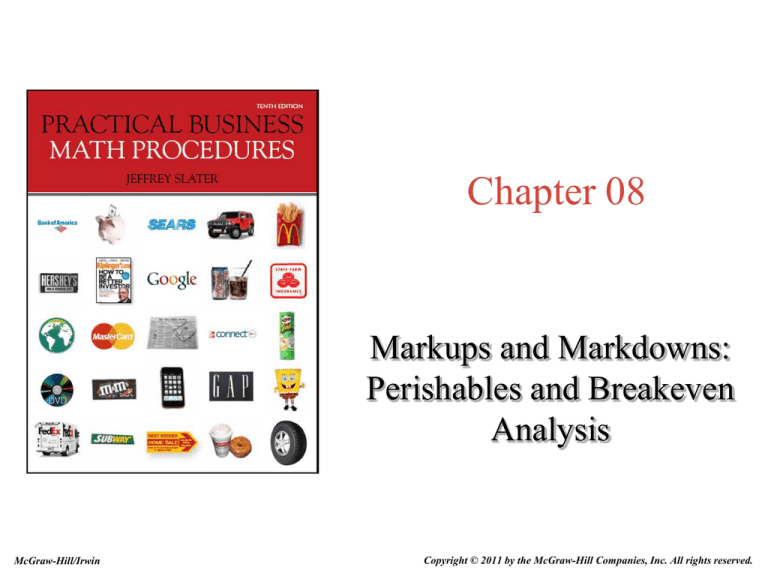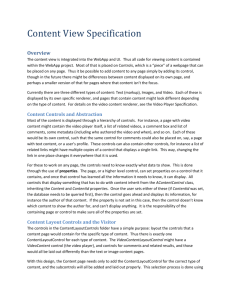
Chapter 08
Markups and Markdowns:
Perishables and Breakeven
Analysis
McGraw-Hill/Irwin
Copyright © 2011 by the McGraw-Hill Companies, Inc. All rights reserved.
#8
Markups and Markdowns; Perishables
and Breakeven Analysis
Learning Unit Objectives
LU8.1
Markup Based on Cost (100%)
1. Calculate dollar markup and percent markup
on cost
2. Calculate selling price when you know cost
and percent markup on cost
3. Calculate cost when dollar markup at
percent markup on cost are known
4. Calculate cost when you know the selling
8-2
price and percent markup on cost
#8
Markups and Markdowns; Perishables
and Breakeven Analysis
Learning Unit Objectives
LU8.2 Markup Based on Selling Price (100%)
8-3
1.
Calculate dollar markup and percent markup on selling
price
2.
Calculate selling price when dollar markup and percent
markup on selling price are known
3.
Calculate selling price when cost and percent markup
on selling price are known
4.
Calculate cost when selling price and percent markup
on selling price are known
5.
Convert from percent markup on cost to percent markup on
selling price and vice versa
#8
Markups and Markdowns; Perishables
and Breakeven Analysis
Learning Unit Objectives
LU8.3 Markdowns and Perishables
1. Calculate markdowns; compare markdowns
and markups
2. Price perishable items to cover spoilage loss
8-4
#8
Markups and Markdowns; Perishables
and Breakeven Analysis
Learning Unit Objectives
LU8.4 Breakeven Analysis
1. Calculating Contribution Margin (CM)
2. Calculating a Breakeven Point (BE)
8-5
Terminology
Cost - The price retailers
pay to a manufacturer or
supplier
Markup, margin, or gross
profit - The difference between
the cost of bringing the goods
into the store and the selling
price
Selling Price - The price
retailers charge customers
Operating expenses or
overhead - The regular
expenses of doing business
such as rent, wages,
utilities, etc.
Net profit or net income - The profit remaining after
subtracting the cost of bringing the goods into the
store and the operating expenses
8-6
Basic Selling Price Formula
Selling price (S) = Cost (C) + Markup (M)
$23
Jean
8-7
$18 - Price
paid to bring
Jeans
into store
$5 - Dollars
to
cover
operating
expenses and
make a profit
Markups Based on Cost (100%)
Dollar markup is
the portion
Cost + Markup = Selling Price
100%
Cost is 100%
- the Base
8-8
27.78%
127.78%
Percent
markup on
cost is the rate
Calculating Dollar Markup and
Percent Markup on Cost
• Gap buys fleece jackets
Dollar Markup = Selling Price - Cost
$5
= $23 - $18
for $18. They plans to sell
them for $23. What is Gap’s
markup? What is the
percent markup on cost?
Percent Markup on Cost = Dollar Markup
Cost
$5 = 27.78%
$18
Check: Selling Price = Cost + Markup
23 = 18 + .2778(18)
$23 = $18 + $5
8-9
Cost (B) =
Dollar Markup
Percent markup on cost
$5 = $18
.2778
Calculating Selling Price When You Know
Cost and Percent Markup on Cost
• Mel’s Furniture bought
a lamp for $100.
To make Mel’s desired
profit, he needs a 65%
markup on cost. What is
Mel’s dollar markup?
What is his selling price?
S
S
S
S
8-10
= C + M
= $100 + .65($100)
= $100 + $65
= $165
Dollar Markup
Calculating Cost When You Know Selling
Price and Percent Markup on Cost
• Jill Sport, owner of Sports, Inc.,
sells tennis rackets for $50. To
make her desired profit, Jill needs
a 40% markup on cost. What do
the tennis rackets cost Jill? What
is the dollar markup?
S = C + M
$50 = C + .40(C)
$50 = 1.40C
1.40
1.40
$35.71 = C
8-11
M = S - C
M = $50 - $35.71
M = $14.29
Markups Based on Selling Price (100%)
Dollar ($)
markup is the
portion (P)
Cost + Markup = Selling Price
78.26%
+ 21.74%
=
100%
Selling Price
is 100% - the
Base (B)
Percent (%)
markup on
selling price is the
rate (R)
8-12
Calculating Dollar Markup and Percent Markup
on Selling Price
• The cost to Gap for a hooded
Dollar Markup = Selling Price - Cost
$5
= $23 - $18
fleece jacket is for $18; the
store then plans to sell them
for $23. What is Gap’s dollar
markup? What is its percent
markup on selling price?
Percent Markup on Selling Price = Dollar Markup
Selling Price
$5 = 21.74%
$23
Check: Selling Price = Cost + Markup
23 = 18 + .2174($23)
$23 = $18 + $5
8-13
Selling Price = Dollar Markup
Percent markup on SP
$5 = $23
.2174
Calculating Selling Price When You Know
Cost and Percent Markup on Selling Price
• Mel’s Furniture bought a lamp
for $100. To make desired profit,
he needs a 65% markup on selling
price. What are Mel’s selling
price and dollar markup?
M = S - C
M = $285.71 - $100
M = $185.71
8-14
S = C + M
S = $100 + .65(S)
-.65s
- .65S
.35s = $100
.35
.35
S = $285.71
Calculating Cost When You Know Selling Price
and Percent Markup on Selling Price
• Jill Sport, owner of Sports, Inc.,
sells tennis rackets for $50. To
make her desired profit, Jill needs a
40% markup on selling price.
What is the dollar markup? What
do the tennis rackets cost Jill?
S = C + M
$50 = C + .40($50)
$50 = C + $20
-20
- $20
$30 = C
8-15
Dollar Markup
Conversion
Formula for Converting
Percent Markup on Cost to
Percent Markup on Selling
Price
Percent markup on cost
1+ Percent markup on cost
.2778 =
1+.2778
8-16
21.74%
Formula for Converting Percent
Markup on Selling Price to
Percent Markup on Cost
Percent markup on selling price
1- Percent markup on selling price
.2174 = 27.78%
1-.2174
Equivalent Markup
Percent markup on
Selling Price
20
25
30
33
35
40
50
8-17
Percent markup on cost
(round to nearest tenth percent)
25.0
33.3
42.9
49.3
53.8
66.7
100.0
Markdowns
Markdown percent = Dollar markdown
Selling price (original)
Sears marked down a $18 tool set
to $10.80. What are the dollar
markdown and the markdown
percent?
$10.80
$7.20
$18.00
40%
8-18
$18-$10.80
Markdown
Pricing Perishable Items
TC
TS
TS
TS
= 300lb. X $.14 = $42.00
= TC + TM
• Alvin’s vegetable stand
= $42 + .60($42)
grew 300 pounds of
tomatoes. He expects 5%
= $67.20
of the tomatoes to become
spoiled and not salable.
300 lbs. X .05 = 15lbs
The tomatoes cost Alvin
Selling
$.14 per pound and he
$67.20 = $.24
Price per wants a 60% markup on
285lbs.
cost.
What price per
pound
pound should Alvin charge
for the tomatoes?
300lbs. - 15lbs
8-19
Break Even Analysis - Terminology
Fixed Cost (FC) – Costs
that do not change with
increases or decreases in
sales
Contribution Margin (CM) –
The difference between selling
price (S) and variable costs
(VC).
Variable costs (VC) – Costs
that do change in response
to changes in the sales
Breakeven Point (BE) – The
point at which the seller has
covered all costs of a unit and
has not made any profit or
suffered any loss.
Selling Price (S) – Price of goods
8-20
Calculating a Contribution Margin (CM)
Contribution margin (CM) = Selling Price (S) – Variable cost (VC)
• Assume Jones Company
produces pens that have a
selling price (S) of $2 and
a variable cost (VC) of
$.80. Calculate the
contribution margin
CM = $2,00 (S) - $.80 (VC)
CM = $1.20
8-21
Calculating a Breakeven Point (BE)
Breakeven point (BE) = Fixed Costs (FC)
Contribution margin (CM)
• Jones Company produces
pens. The company has
fixed cost (FC) of $60,000.
Each pen sells for $2.00
with a variable cost (VC)
of $.80 per pen.
Breakeven point (BE) =
8-22
$60,000 (FC)
= 50,000
$2.00 (S) - $.80 (VC)
Problem 8-19:
Solution:
Dollar markup = S – C
$3,000
Percent markup on cost =
$12,000 = 25%
$3,000 = $15,000 - $12,000
Check:
C=
8-23
Dollar markup
. = $3,000 = $12,000
Percent markup on cost
.25
Problem 8-21:
Solution:
$20 = C + .40C
$20 = 1.40C
1.40 1.40
$14.29 = C
Check:
Selling price
_
Cost = 1 + Percent markup on cost
$14.29 = $20
1.40
8-24
Problem 8-24:
Solution:
Markup = $1.50 - $.42 = $1.08
$1.08/.42 = .25714 = 257.14%
Check: $1.50 = $.42 + 257.14(.42)
$1.50 = $.42 + 1.08
$1.50 = $1.50
8-25
Problem 8-25:
Solution:
$120 = C + .30($120)
$120 = C + $36
-36
-36
$84 = C
Check:
C = Selling price x (1- Percent markup on selling price)
$84 = $120 x .70
8-26
Problem 8-29:
Solution:
Total cost = 100 x $2.00 = $200
Total selling price = TC + TM
TS = $200 + .60($200)
TS = $200 + $120
TS = $320
Selling price per cookie =
$320 = $3.56
90 cookies
(100 cookies – 10%)
8-27







